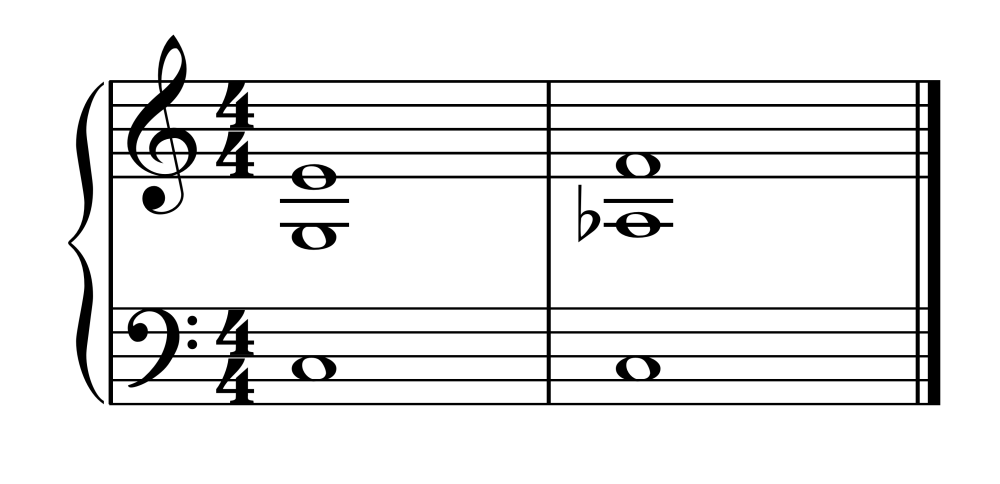This week let’s look at what I regard as being a kind of reverse of the mystery scale from the previous scale-of-the-day post. Just as in our ‘mystery scale’ this is a major scale with a change made to only one note, but whereas last time we raised the 5th, this time we are lowering the 6th: same pitch, different degree, and very different end result.
Here it is on C:
 It’s called Major-Harmonic in a fairly obvious way, the tail of the harmonic has been attached to the head and torso of the major pattern, and here’s our hybrid.
It’s called Major-Harmonic in a fairly obvious way, the tail of the harmonic has been attached to the head and torso of the major pattern, and here’s our hybrid.
Being, to our diatonic ears, a hybrid, one might unthinkingly assume that this scale is a curiosity, rather than descriptive of real life music-making.
But take a listen to the chords this pattern makes:
The most significant change from the major scale triads is the chord IV is now chord iv – yep, it’s minor. [And along with that we have a diminished ii and an augmented VI.] This minor chord ivand diminished chord ii are what we need to make one of the most used cadences of the 20th century:
I’ve heard this referred to as the Hollywood cadence, and that label really sums it up!
The chord progression
is a staple of the popular song – just hearing these chords moving from one to the other (especially with a soft electronic piano sound) evokes a torrent of lyric clichés just aching to attach themselves to this progression.
And once you have these clichés in your head, it’s hard to think what else this scale is good for.
Am I being too harsh? Dismissing the pattern as being of limited and prescribed value? Dissing the emotional content as pre-fabricated and predictable?
Well, one disclaimer: the scale is rarely strong enough to sustain an entire composition – one section of a song or piece might utilise this pattern for a while, but relief is needed, and it nearly always comes in the form of both a modulation to a new tonal centre and a new scale pattern.
Does this observation reflect how things need to be, or simply that composers have found this a convenient quick-fix for whatever emotional short-comings their compositions may have had? Are there pieces out there that do something with this scale beyond exploiting the tug of that minor chord iv?
I’d love to think this scale is the basis of something more profound than generic unrequited love songs!




I think using the “harmonic major” scale to justify the iv minor or ii diminished or V7(b9) in a major context is going a little out of your way to try to apply a scale theory to a situation that just doesn’t need it. All of those sorts of chords are simply examples of modal interchange between major and minor, and none really get to the “meat” of the harmonic major in full when contextualized in those sorts of cliche cadences.
I think harmonic major is an absolutely fantastic scale. It and its modes are very cool, and none of them, with the possible exception of mode III, are part of the jazz improvisation canon. It doesn’t have to rely on the tired sorts of modal interchanged progressions, especially when the b6 is incorporated into the tonic sound.
I’ve written a couple things in Mode II of harmonic major (dorian b5, hopefully you’ll mention that scale at some point), and recently I’ve tried my hand at writing a purely diatonic harmonic major composition (link below). It’s a great sound, but you have to go outside purely tertian concepts of harmony in order to exploit all of its nuance. The major triad formed between the b6, 7 and 3 is a particularly cool upper structure for a lot of chord roots that really gets at the “meat” of the mode.
http://adamneely.com/2010/02/16/ahm-etudes/
Yes, Harmonic Major is tertian so it is a tonality like the others. Also, the IV minor chord has a major 7th, so it can be a tonic minor, unlike Harmonic Minor which has a IV minor 7th. http://www.RxSound.com “Sleepwalk” borrows chords from Harmonic Major. Nice to see someone appreciating this scale….Adam Coulombe, Montreal